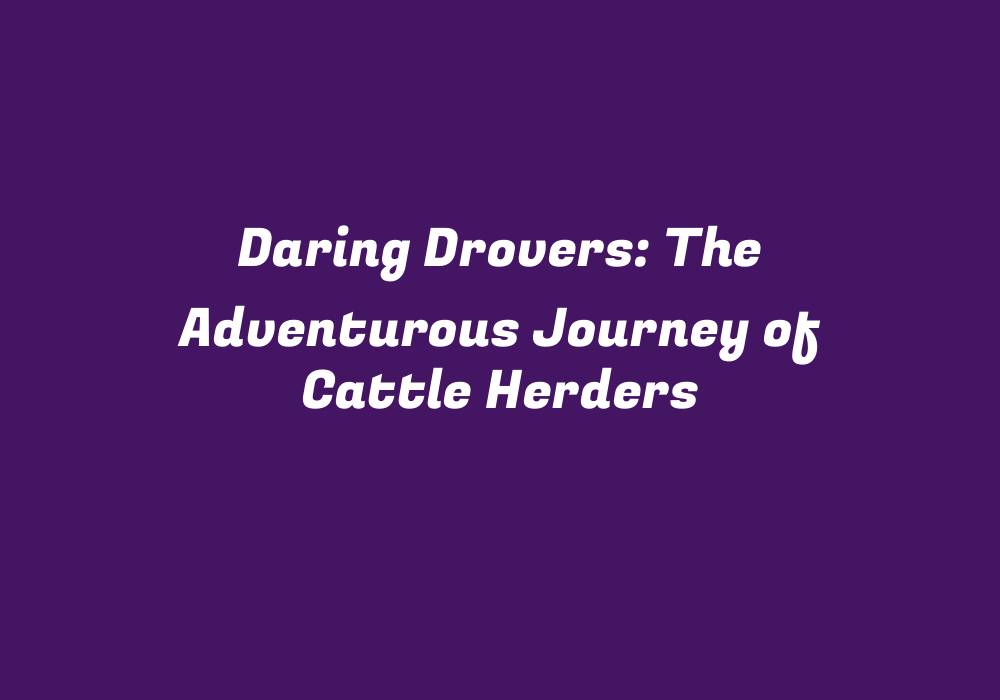Introduction: The Role of Daring Drovers in History
Before modern transportation, cattle herding was an essential part of life that connected various communities across vast landscapes. Driving these animals from one location to another was a risky yet rewarding profession, and it took strong-willed individuals called drovers to ensure their survival through the rigors of the journey. These adventurous cattle herders not only played a significant role in shaping early societies but also contributed to our understanding of human resilience and resourcefulness.
The Beginning: Early Roots of Cattle Herding
Cattle herding dates back thousands of years, with ancient civilizations relying on these animals for food, work, and as symbols of wealth. As humans migrated across continents, they needed a way to transport their cattle over long distances. This led to the development of drovers who were responsible for guiding them safely from one point to another.
Droving Methods: Navigating Hazards on the Road
Cattle drives in the 18th and 19th centuries involved numerous challenges that tested both man and beast. Herders had to adapt their techniques to overcome different obstacles they encountered throughout their journey, such as rivers, mountain passes, and rough terrain. Some drovers even developed methods for driving cattle through dense forests using trails or clearing pathways as they went along.
Major Routes: The Great Western Trails of America
Some of the most famous cattle drives in history occurred across the American West. The Chisholm Trail, which connected Kansas to Texas, was one of the major routes used for moving livestock from one region to another during the 1860s and 1870s. The trail became so well-known that it inspired the term ‘Chisholming’ – the act of moving cattle in large numbers from one place to another.
The Dangers Along the Trail: Bandits, Wildlife, and Weather
Drovers faced a multitude of dangers while traveling along these trails. One of their primary concerns was bandits who targeted drovers for easy access to cash, food, and cattle. As a result, many drovers carried weapons or employed armed guards to protect themselves and their herds. Wildlife also posed a threat, with coyotes, wolves, and even grizzly bears known to attack cattle or the drovers themselves.
Another significant challenge that drovers encountered was extreme weather conditions during various seasons along their journeys. In summer, they dealt with sweltering heat, while in winter, they navigated through harsh snowstorms and icy terrain. These environmental factors often forced them to adapt their methods on the go to ensure both cattle and themselves survived the arduous journey.
Drovers’ Contribution to Western Culture: The American Cowboy Mythos
As drovers moved cattle from one region to another, they interacted with a diverse range of people – from Native Americans to settlers and other travelers. These encounters led to a rich exchange of ideas and contributed to the formation of what we now know as the ‘American West’. It was during this period that the iconic image of the independent-minded cowboy emerged, inspiring generations of storytellers and filmmakers who have continued to celebrate this unique aspect of American culture.
Legacy of Daring Drovers: Preserving Cattle Herding Traditions Today
While droving is no longer the primary means of transporting cattle across vast distances, the traditions and skills of these daring herders are still present in various parts of the world today. In countries such as Australia, ranchers continue to use their knowledge of livestock behavior and the land to manage and move their cattle from one pasture to another.
Moreover, there has been a resurgence in interest in historical cattle drives, with re-enactments and living history programs allowing modern audiences to experience the hardships that drovers faced during their epic journeys. These events not only celebrate the rich heritage of cattle herding but also serve as an important reminder of the remarkable bravery, determination, and adaptability displayed by those who once dared to be called daring drovers.
